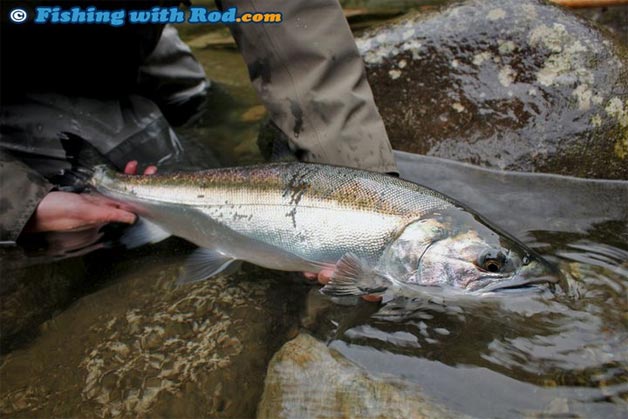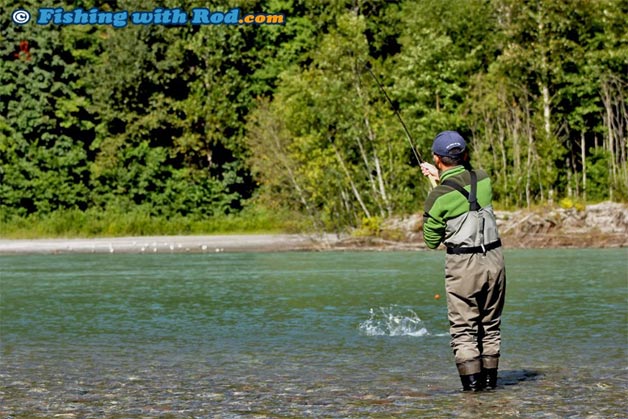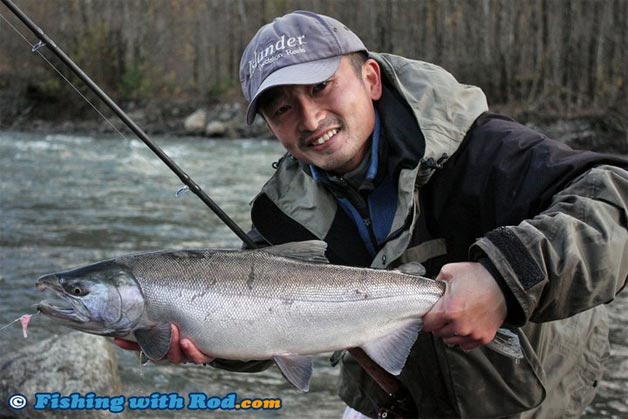Fishing in BC: Salmon in Freshwater
By Rodney Hsu, Fishing with Rod

Beside being targeted in the ocean, Pacific salmon are widely caught in rivers when they return to spawn in their natal streams. Freshwater salmon fisheries in British Columbia are very popular because they can be done without a boat most of the time, so the cost is much lower than saltwater salmon fishing. Every season, tens of thousands of both local and visiting anglers enjoy catching salmon at the last phase of their adult life, when the largest specimen are found. You can either access many salmon streams in British Columbia on foot, or you can hire a guide who takes you to more remote streams by a jet boat. Either way, you can find spectacular fishing more often than not.
Five Pacific salmon are targeted at different time of the year, depending on when they return to their natal streams to spawn. The timing of their return depends on several factors, which are the species, the latitude of their natal stream and the distance between the estuary and their spawning ground. All five species return in different times of the year, but their timings may often overlap. Salmon tend to return earlier in northern part than southern part of British Columbia due to the difference in the length of summer. If the distance between the river mouth and their spawning ground is long, then salmon will enter the system earlier than salmon that return to short coastal streams.

Chinook salmon are the largest of all Pacific salmon when they are found in rivers. A matured chinook salmon can be as large as 50lb, but most fish are usually between 10 and 30lb. They are targeted in large systems such as the Fraser River by bar fishing, as well as in smaller streams where other fishing methods such as fly fishing are possible. Interior chinook salmon enter the Fraser River and Skeena River as early as April and May, while Southern BC's coastal chinook salmon return between August and October.
Early sockeye salmon that return to the Upper and Mid Fraser River enter the system in June, while the bulk of the Fraser River sockeye return in July and August. In some coastal streams, sockeye returns take place in September. Ranging from 5 to 10lb, sockeye salmon are picky biters but spectacular fighters. They can be caught with bait, lures and flies but they do not strike as often as other salmon species.
Coho salmon are very popular among freshwater salmon anglers. The season for targeting these silver acrobats is between August and December. Their average size is between 2 and 12 lb, but fish as large as 20lb are caught from time to time. Coho salmon can be caught by float fishing with bait, casting and retrieving a lure or a fly. Coho salmon fishing in rivers can be very moody. The bite can be on for a short while and switch off instantly due to lighting, temperature, water level and disturbance by anglers.
Pink salmon are the smallest Pacific salmon because their life span is only two years. Their average size is between 4 and 6lb. They return to most coastal streams, but some systems only see them once every two years. For example, pink salmon fishing is only available in the Fraser River and its tributaries during odd years. When a school of pink salmon swim by, nobody can keep them off the hooks. They will always eagerly chase down a lure or a fly. This makes them the perfect salmon species on light tackle and for families who wish to be out fishing for the day. On Vancouver Island and northern part of British Columbia, pink salmon return to rivers in July and August, while the best month for targeting them in tributaries of the Lower Fraser River is September.
Chum salmon are the late arrivers. They are often the last salmon species found in a river. Characterized by their stripe-coloured body and fang-like teeth, these fish can give any freshwater angler a real workout. They are usually found in rivers between September and November. Anglers enjoy catching them in rivers by fly fishing in the lower section of a river where fish are generally fresher.
In the estuary part of a river where current is mainly influenced by the tide, salmon are targeted by spincasting with lures, bottom fishing with bait and fly fishing. To be successful in this fishery, you need to time your outing with the tide. Generally, an incoming tide can bring in schools of returning fish and an outgoing tide can sometimes make fish retreating back toward the river mouth due to low water level in the river. The freshest salmon in a river are caught in this section due to the proximity from the ocean. They are also the strongest.

Once salmon return to a stream, they will travel up rapids and rest in runs and pools. Runs with a walking pace current is where salmon can be found resting before moving further upstream. The most common method of targeting salmon in a run is by float fishing with a variety of presentations. These presentations can be natural bait such as salmon roe, dew worms, or artificial offerings such as a piece of wool tie, plastic eggs. As the presentation drifts downstream, salmon will often react and bite it. Spincasting lures can also be quite effective in slower runs. A spoon or a spinner resembles a small trout or coarse fish that poses a threat to eggs that salmon are laying. By casting and retrieving a lure across waters where salmon are resting, it can trigger bites as these fish are often territorial.
Returning salmon can also be found in ponds, lakes and slow pools that are found between river channels. if freshly arriving salmon are undisturbed, these "frog waters" can be extremely productive. You can either cast and retrieve a metal lure, or fly fish by casting and slowly stripping in a small streamer. Salmon resting in pools will often follow your retrieved presentation without striking. When this occurs, adjust your retrieve speed or change your presentation until you find the right formula. The bite can suddenly turn on after many attempts, so be prepared for surprises.
When it comes to freshwater salmon fisheries in British Columbia, there are many different options to choose from. Your challenge is not having a lack of fish to catch, but a lack of time to experience them all.

